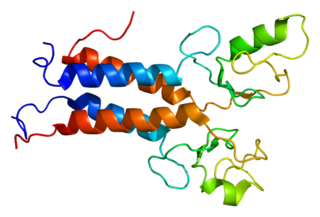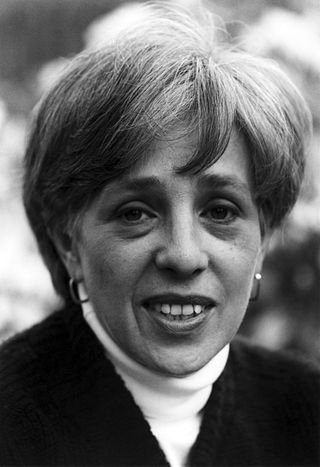
Bioinformatics is an interdisciplinary field of science that develops methods and software tools for understanding biological data, especially when the data sets are large and complex. Bioinformatics uses biology, chemistry, physics, computer science, computer programming, information engineering, mathematics and statistics to analyze and interpret biological data. The subsequent process of analyzing and interpreting data is referred to as computational biology.

Breast cancer type 1 susceptibility protein is a protein that in humans is encoded by the BRCA1 gene. Orthologs are common in other vertebrate species, whereas invertebrate genomes may encode a more distantly related gene. BRCA1 is a human tumor suppressor gene and is responsible for repairing DNA.

UK Biobank is a large long-term biobank study in the United Kingdom (UK) which is investigating the respective contributions of genetic predisposition and environmental exposure to the development of disease. It began in 2006.

A splice site mutation is a genetic mutation that inserts, deletes or changes a number of nucleotides in the specific site at which splicing takes place during the processing of precursor messenger RNA into mature messenger RNA. Splice site consensus sequences that drive exon recognition are located at the very termini of introns. The deletion of the splicing site results in one or more introns remaining in mature mRNA and may lead to the production of abnormal proteins. When a splice site mutation occurs, the mRNA transcript possesses information from these introns that normally should not be included. Introns are supposed to be removed, while the exons are expressed.

Mary-Claire King is an American geneticist. She was the first to show that breast cancer can be inherited due to mutations in the gene she called BRCA1. She studies human genetics and is particularly interested in genetic heterogeneity and complex traits. She studies the interaction of genetics and environmental influences and their effects on human conditions such as breast and ovarian cancer, inherited deafness, schizophrenia, HIV, systemic lupus erythematosus and rheumatoid arthritis. She has been the American Cancer Society Professor of the Department of Genome Sciences and of Medical Genetics in the Department of Medicine at the University of Washington since 1995.

Myriad Genetics, Inc. is an American genetic testing and precision medicine company based in Salt Lake City, Utah, United States. Myriad employs a number of proprietary technologies that permit doctors and patients to understand the genetic basis of human disease and the role that genes play in the onset, progression and treatment of disease. This information is used to guide the development of new products that assess an individual's risk for developing disease later in life, identify a patient's likelihood of responding to a particular drug therapy, assess a patient's risk of disease progression and disease recurrence, and measure disease activity.

Roxana Moslehi is an Iranian-born genetic epidemiologist.

CHEK2 is a tumor suppressor gene that encodes the protein CHK2, a serine-threonine kinase. CHK2 is involved in DNA repair, cell cycle arrest or apoptosis in response to DNA damage. Mutations to the CHEK2 gene have been linked to a wide range of cancers.

A biobank is a type of biorepository that stores biological samples for use in research. Biobanks have become an important resource in medical research, supporting many types of contemporary research like genomics and personalized medicine.

BRCA1-associated RING domain protein 1 is a protein that in humans is encoded by the BARD1 gene. The human BARD1 protein is 777 amino acids long and contains a RING finger domain, four ankyrin repeats, and two tandem BRCT domains.

LIM domain only 2, also known as LMO2, RBTNL1, RBTN2, RHOM2, LIM Domain Only Protein 2, TTG2, and T-Cell Translocation Protein 2, is a protein which in humans is encoded by the LMO2 gene.

LIM domain-binding protein 1 is a protein that in humans is encoded by the LDB1 gene.

Tumor protein D52 is a protein that in humans is encoded by the TPD52 gene.

LIM domain transcription factor LMO4 is a protein that in humans is encoded by the LMO4 gene.

Maxine Frank Singer is an American molecular biologist and science administrator. She is known for her contributions to solving the genetic code, her role in the ethical and regulatory debates on recombinant DNA techniques, and her leadership of Carnegie Institution of Washington. In 2002, Discover magazine recognized her as one of the 50 most important women in science.
Vanessa Hayes is a geneticist conducting research into cancer genomics and comparative human genomics. She leads a research group at the Garvan Institute of Medical Research in Sydney Australia and holds the Petre Chair of Prostate Cancer Research at the University of Sydney.

Katherine Belov is an Australian geneticist, professor of comparative genomics in the School of Life and Environmental Sciences and Pro Vice Chancellor of Global Engagement at the University of Sydney. She is head of the Australasian Wildlife Genomics Group and research expert in the area of comparative genomics and immunogenetics, including Tasmanian devils and koalas, two iconic Australian species that are threatened by disease processes. Throughout her career, she has disproved the idea that marsupial immune system is primitive, characterized the South American gray short-tailed opossum's immune genes, participated in the Platypus Genome Project, led research identifying the properties of platypus venom, and identified the cause of the spread of the Tasmanian devil's contagious cancer.
Association for Molecular Pathology v. Myriad Genetics, Inc., 569 U.S. 576 (2013), was a Supreme Court case, which decided, that "a naturally occurring DNA segment is a product of nature and not patent eligible merely because it has been isolated.” However, as a "bizzare conciliatory prize" the Court allowed patenting of complementary DNA, which contains exactly the same protein-coding base pair sequence as the natural DNA, albeit with introns removed.
Douglas F. Easton FMedSci is a British epidemiologist who conducts research on the genetics of human cancers. He is Professor of Genetic Epidemiology and Centre for Cancer Genetic Epidemiology at the University of Cambridge. He founded Cambridge's Cancer Research UK Genetic Epidemiology Unit in 1995, and was a Principal Research Fellow there from 2001 to 2011. He is a Professorial Fellow of Homerton College, Cambridge.
Maria Jasin is a developmental biologist at the Memorial Sloan Kettering Cancer Center. She is known for studying homologous recombination, a method in which double-strand breaks in DNA strands are repaired, and for discovering the role of BRCA1 and BRCA2 in cancers.















